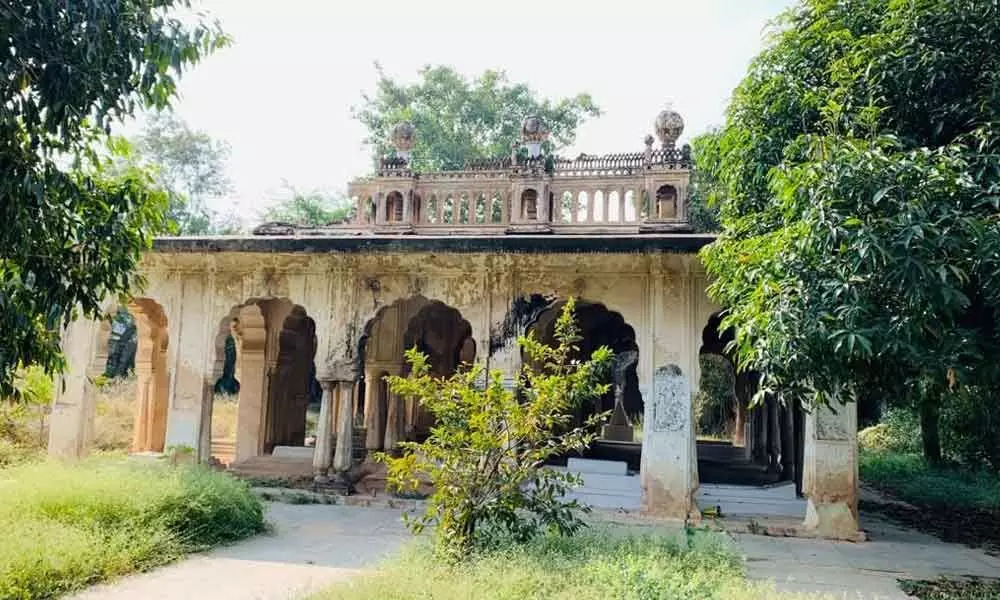Live
- Activist Alleges CPCB Cover-up on Endosulfan in Kasaragod
- Theft Case of Thumbe Mahalingeshwara Temple
- DIY vs professional car detailing: Pros and Cons
- Wild Elephant Gets Stuck at Rail Track Fence Forest Department Frees Animal
- CERT-In Issues Critical Security Alert for Apple Users: Update Your Devices Now
- Kolar’s Compassionate Leap: Mechanical Elephant Leads Temple Procession
- Centre to unveil startups under new National Quantum Mission guidelines
- Women’s protest rally in Imphal against re-imposition of AFSPA in 6 police station areas
- Greater Nicobar Island project has all environmental clearances: Govt
- Fadnavis leaves for Delhi, expected to meet Amit Shah along with Shinde, Ajit Pawar
Just In
Hyderabad: Grand enough to amaze anyone


Restoration of their architectural spelndour by both Central & State govts is on
Restoration of their architectural spelndour by both Central & State govts is on
It is very rare that a visit to tomb or mausoleum can be a tourist attraction. But structures stand out as monuments drawing people, as the place exudes splendour a bygone era. Among such tombs, though not very popular on par with Qutubshahi Tombs, in Hyderabad are Paigah Tombs.
For discerning people, the Paigah tombs mean beautiful views and architectural excellence of the 19th century Indo-Saracenic architecture in a fusion of Asaf Jah and Rajputani styles. There is something magical about any place that stands vagaries of time and retains its original charm, fully or in part.
At the Paigah Tombs complex, Santosh Nagar, the main attraction is Maqhbara Shams-al-Umara, the resting place of Paigah nobles who were fierce warriors of the Nizam. It was built in the 18th century. Tombs are adorned with stucco work, variously encapsulating the styles of Mughal, Greek, Persian, Asaf Jah, Rajasthani and Deccani.
The restoration works were proposed to be undertaken by the Aga Khan Trust for Culture (AKTC) in partnership with the Department of Heritage Telangana. The works began from Ghansimiyan's Tomb, which was built in memory of Sardar-ul-Mulk Ghansi Miyan, a commander in the Nizam's army, while the landscape works are being supported by Swadesh Darshan Grant, Ministry of Tourism. Even the State government proposed to develop the place with various amenities. Proposed works include better landscaping of tombs, mosque, a water body and an entrance gateway.
According to sources, the works were started in the second quarter of this year, but the authorities could not make any progress, given the COVID impact on the tourism and sectors. The conservation works of Ghansimiyan's Tomb was started, but even that was left incomplete and only the works of flooring were completed.
Ghansimiyan tomb is situated in the southwest corner of Paigah tombs. Apart from the tombs, the collapsed walls of the Samakhana were being reconstructed using rubble stone and rich lime plaster, but these works also remain pending since lockdown.
HISTORY OF PAIGAS
The noble families of Paigah, during the 18th century were the most influential and powerful families of the Princely State of Hyderabad with comprising the area of their Jagirs to 4000 sq. miles. Their ancestor was Abdul Fateh Khan Tegh Jung who came to Deccan with Asaf Jah I and founded the Paigah nobility. He rendered service to the second Nizam, who ruled between 1760 and 1803 and received the highest position of Commander in chief with the title of Shams-ul-Umra.
They constructed several palaces in the city notable among which were Asman Garh Palace, Khursheed Jah Devdi, Vicar-ul-Umarahi palace and also the famous Falaknuma Palace. They were believed to be wealthier than the average Maharajah of the country and were the only ones to have the privilege of maintaining their own court, palaces, as well as their own private armies, which often numbered several thousand.
Abdul Fateh Khan Tegh Jung was the first who buried in 1786 in Paigah Tombs, which later became the family Maqhbara built as per the generations of the members of their families, mostly renovated by his son Amir-e-Kabir I (in the 1880s some additions were made by Sir Asman Jah, Sir Khurshid Jah, and Sir Vikar-ul-Umra), the tombs of several generations of the Paigah nobles include Abul Fatah Khan Shums-ul-Umra I to Shums-ul-Umra V, Sir Asman Jah, Sir Khursheed Jah, Sir Vicar-ul-Umra, Sultan-ul-Mulk, Lady Vicar-ul-Umra, Lady Khurshid Jah, Lady Asman Jah, Moin-ud-Dowla, Zaheer yar Jung, Zayd Yar Khan and other members of the Paigah Family.
MAGNIFICENT PIECES OF ART
All tombs have been beautifully carved and are magnificent pieces of art. The detail of the stucco work on these structures is intricate. They have become extremely popular because of the geometrical features carved on them. Apart from the geometrical designs, the floral designs, trellis marble fencing, and canopies are also very intricate and beautiful. Most of the tomb enclosures are open sky with intricate carvings on marble and jade tombs.
The Tomb of Asman Jah and Begum Khurshid Jah attract a maximum number of tourists. The structures are made of marble and were once adorned with precious and semi-precious stones which changed colours with the change of seasons. The Tombs are enclosed by a wall which is ornamented with lattice work and exotic floral and geometric designs. Each wall is done up differently with fruits, drums, serpents, flowers, vases, etc.

© 2024 Hyderabad Media House Limited/The Hans India. All rights reserved. Powered by hocalwire.com






